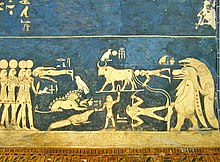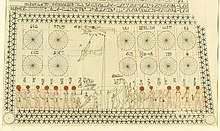| Ikhemu-sek | |
|---|---|
 The Ikhemu-sek, depicted in the tomb of Pharaoh Seti I (KV17) Nineteenth Dynasty, astronomical vaulted ceiling Valley of the Kings | |
| Symbol | Stars, constellations |

The Ikhemu-sek (Ancient Egyptian: j.ḫmw-sk – literally "the ones not knowing destruction"[1] also known as the Imperishable ones) were a group of ancient Egyptian minor deities who where the personifications of the northern constellations.[2]
History[edit]
The northern constellations were depicted in the tomb of Senenmut on the astronomical ceiling.[2] The Ikhemu-sek were also found on the astronomical vaulted ceilings of tombs in the Valley of the Kings.[2]
Iconography[edit]
The Ikhemu-sek where portrayed as both animal and human-like: A woman, lion (leo), bull, man, falcon-headed man, man, and hippopotamus.
See also[edit]
References[edit]
- ^ Teresi, Dick (2002-12-22). "The Nation; The Universe and Ground Zero". The New York Times. ISSN 0362-4331. Retrieved 2023-02-15.
- ^ a b c "Culture and Education:Opinion:WASEDA ONLINE". yab.yomiuri.co.jp. Retrieved 2023-02-15.

Well, that’s interesting to know that Psilotum nudum are known as whisk ferns. Psilotum nudum is the commoner species of the two. While the P. flaccidum is a rare species and is found in the tropical islands. Both the species are usually epiphytic in habit and grow upon tree ferns. These species may also be terrestrial and grow in humus or in the crevices of the rocks.
View the detailed Guide of Psilotum nudum: Detailed Study Of Psilotum Nudum (Whisk Fern), Classification, Anatomy, Reproduction